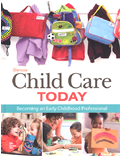
Child Care Today ©2012Chapter 23: Art, Music, and MovementChapter SummaryArt is the use of skills and imagination to produce something that expresses thoughts, ideas, or emotions. Well-planned art activities develop physical, language, thinking, emotional, and social skills, as well as basic concepts and an appreciation of diversity. Children go through predictable stages in learning to create art. Well-stocked art centers invite children to select art activities according to their interests and abilities. Continuously supervise art activities and follow safety rules. When guiding art activities, value the process and encourage creativity. Accept and appreciate children’s art, and display it appropriately. Materials should be provided in art centers for drawing and coloring; painting; finger painting; modeling and shaping; cutting and tearing; and pasting, gluing, and attaching. During music activities, children learn to recognize and enjoy all kinds of music styles and instruments. Music activities benefit all types of development. Music centers should be set up for small and large groups, and should be available to children during playtime. Rhythm instruments allow children to explore music. Teachers do not need to be musically inclined to guide musical activities. Avoid pressuring children to perform in front of others. Music can be related to other curriculum activities. Show children how to use musical instruments, and incorporate musical activities into classroom routines. Plan activities to strengthen small- and large-motor skill coordination. Use creative movement to encourage active participation. Use large open spaces with flat areas that offer safe footing. The elements that make up creative movement are body awareness, force and time, space, locomotion, weight, and moving in groups. Including active play in curriculum encourages overall health and wellness, and increases the chances of maintaining a healthy lifestyle as children grow. Create separate outdoor play spaces for infants and toddlers, preschoolers, and school-age children. Indoor play areas may include small-scale climbers; riding toys; and soft, flexible, active play props. Follow safety guidelines for active play areas and equipment. Materials should encourage a range of physical skill development. Active play activities might include parachute play; beanbag and balloon play; rope and hoop play; balance beams, obstacle courses, and mazes; games; and active water and snow play. |  |















